Courses:PHYS341/2021/Project3

Theremin is one of the first electronic instruments that was invented. It is also one of the only instruments that a musician can play without physically touching. A musician would move their hand (usually the right) around an antenna; depending on the distance between the hand and the antenna, the pitch generated will be different. Most standard theremins have a second antenna that allow a musician to change the volume by hovering their hand (usually the left) on top of it. Other setups of theremins may allow change of volume by stepping on a foot pedal or digitally through a mixer.
History

The theremin was invented by a Russian scientist named Leon Theremin in the 1920s (Figure 2). Theremin was designing a device to measure the density and the properties of gases around an antenna. Depending on the gases that are surrounding the antenna the signal given off by the antenna would be different. Theremin then realized that, when his hands moved around the antenna, the signal given off changed with the proximity to the antenna. He then made adjustments to the setup, including adding a second antenna to alter the volume, and gave the name aetherphone. Theremin then started collaborating with RCA in the United States to commercially produce the device. In the 1950s, Robert Moog was aspired by the theremin, and assembled a theremin based on the schematics in a hobby magazine at age 14. He then started making theremin kits at age 19 for customers to build their own theremin. His company has made some additions to the theremin, including knobs that allow the change of timbre produced, and additional models that allow autotuning of the signal produced. Moog is one of the companies that consistently produce theremins and theremin kits up to this day.
The theremin was meant to contribute to the classical music genre. In that, one of the most famous theremin player Is Clara Rockmore, who was one of the students of Leon Theremin. A notable inclusion of the idea of theremin into Rock Music in the 1970’s was by Led Zeppelin’s Jimmy Page, in Figure 4, in the song “Whole Lotta Love.” The theremin was used also in the television and films industry to produce spooky or outer space sound effects, such as the prelude in the 1951’s movie “The Day the Earth Stood Still”, composed by Bernard Herrmann and performed by Dr. Samuel J. Hoffman.
Physics

The pitch antenna and the right hand (the pitch hand) acts as two sides of a capacitor. A capacitor is a device that stores electric energy through an imbalance of charges on two plates and their interaction with what is called dielectric material. A basic diagram is shown in Figure 5. Different dielectric material changes the amount of energy that can be stored, and so does the distance between the two plates. It is worth mentioning that Leon Theremin was testing the dielectric effects of different gases before he came up with the idea of the theremin.
In the case of the theremin, the dielectric material is air. The stored energy of the capacitor then drives an oscillator in a circuit to produce alternating current at one frequency. The frequency of the oscillator changes depending on the proximity of the pitch hand to the pitch antenna but is out of the human audible range. This current is then mixed with another alternating current driven at a fixed frequency by a device called a “heterodyne mixer” to produce a new frequency that matches frequency in the human audible range. This signal is then sent into a speaker to produce sound. When the pitch hand is further from the pitch antenna, the frequency produced by the mixer is lower, causing the pitch heard to be lower. A similar setup is employed to change the voltage of the signal, which alters the volume of the sound produced.
Playing Technique
While it is very easy to make sound out of a theremin, it is very difficult to produce music that is considered enjoyable, as it requires precise hand gestures to be able to produce correct notes. A beginning practice is to be familiar with a particular range of hand gesture that produces all the notes of one octave (for example, from middle C to the next C), which can be very different depending on the playing style of musicians. Modern theremin can be tuned to match the hand motion of the musician. It also requires the musician to be very sensitive to pitch changes, therefore a musician with perfect pitch or one who has gone through extensive pitch ear training would find the theremin easier to master. Due to the pitch-sensitive nature of the theremin, it is very easy to create a vibrato effect by vibrating the right hand (the pitch hand). Similarly, depending on how fast one moves the hand, it is easy to control how a note sounds.
Properties (of a modern theremin)
Pitch
The relationship between the distance from the pitch hand to the pitch antenna is nonlinear. For a major part of the notes playable by a modern (digital) theremin such as the Moog Etherwave, the relationship appears exponential, as shown in Figure 5. For an analog theremin the curve is slightly different. An additional pitch knob can be found in various models to tune the theremin to change the sensitivity of the instrument, and effectively altering the distance range that a hand needs to be in proximity with the antenna to produce sound.
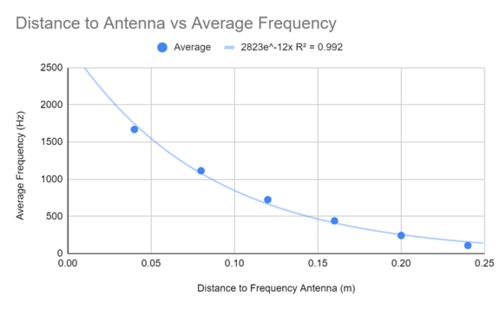
Volume
Similar to the pitch antenna, the relationship between the distance from the volume hand to the volume antenna is non-linear, as shown in Figure 6. An additional pitch knob can be found in various models to vary the maximum volume of sound a theremin can produce.
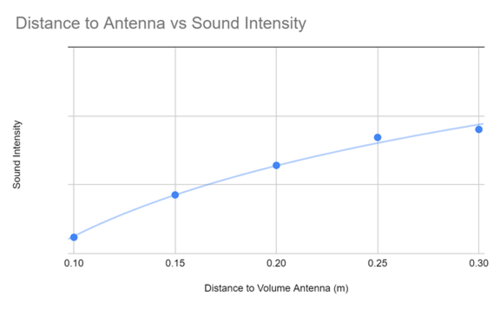
Waveform (available on the Moog Etherwave)
The waveform knob adjusts the emphasis placed on different combinations of overtones, in order to produce different timbre of sound. For example, some models allow adjustments to make the time graph look like a sinusoidal function or triangle wave, while other models may allow additional wave functions, such as square waves, to be produced. A comparison of three different settings while played at 753 Hz (F#) can be found in Table 1. The effect is more evident with a higher brightness; users have reported that waveform setting at high makes the theremin produce a sound that is close to the timre of a violin, while a setting at low makes the timbre similar to that of a clarinet.
| Waveform Setting | Time Graph | Plot Spectra | |
|---|---|---|---|
| Left | 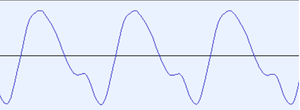 |
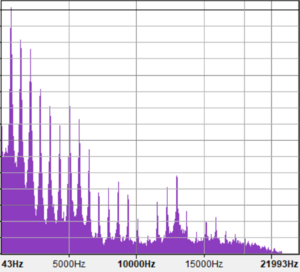 |
|
| Middle | 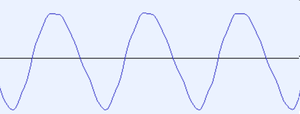 |
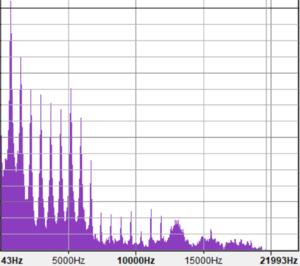 |
|
| Right | 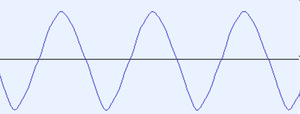 |
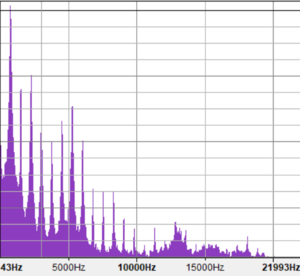 |
Brightness (available on the Moog Etherwave)
The brightness knob adjusts the emphasis placed on the ranges of overtone. Plot spectrum graphs show lower brightness setup emphasizing the lower overtones while higher brightness setup emphasizing the higher overtones. This also changes the wave function that is shown in the time graph. A comparison can be found in Table 2 with three different setting played at 742 Hz (F#).
| Brightness | Time Graph | Plot Spectra | |
|---|---|---|---|
| Low | 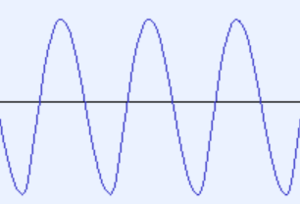 |
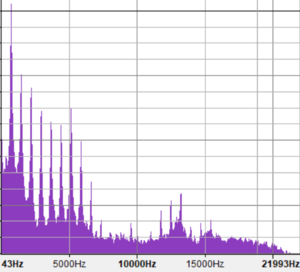 |
|
| Mid | 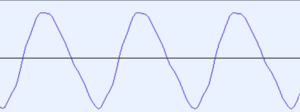 |
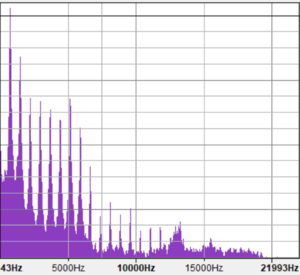 |
|
| High | 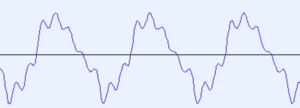 |
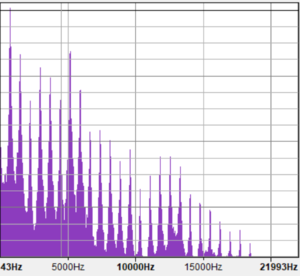 |
References
Skeldon, K. D., Reid, L. M., McInally, V., Dougan, B., & Fulton, C. (1998). Physics of the Theremin. American Journal of Physics, 66(11), 945–955. https://doi.org/10.1119/1.19004
Etherwave Standard | Moog. (n.d.). https://www.moogmusic.com/products/etherwave-standard.
Barile, J. (2005, December 7). What's a Theremin? Theremin World. http://www.thereminworld.com/Article/14232/what-s-a-theremin-.
YouTube. (2017, December 13). Bernard Herrmann - The Day The Earth Stood Still (Theremin Takes). YouTube. https://www.youtube.com/watch?v=BX-Xfiqqi3Q .
scishow. (2016, April 21). The Physics of the Weird and Wonderful Theremin. YouTube. https://www.youtube.com/watch?v=KDG15-iTJLw.
Etherwave "Waveform" knob question. Theremin World. http://www.thereminworld.com/Forums/T/27423/etherwave-waveform-knob-question